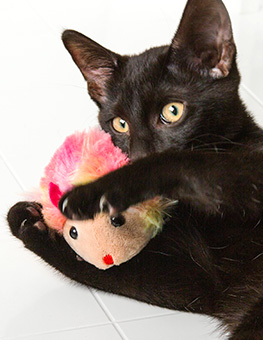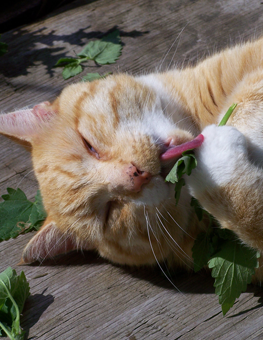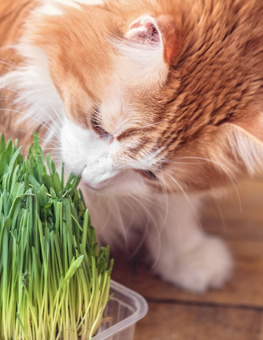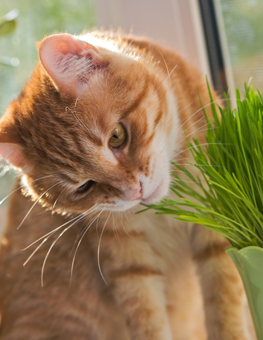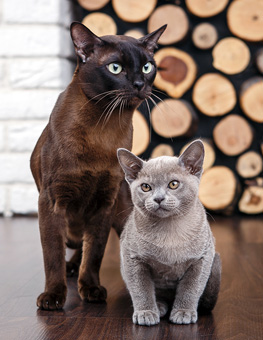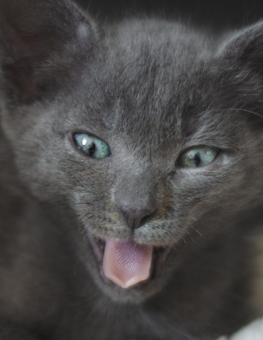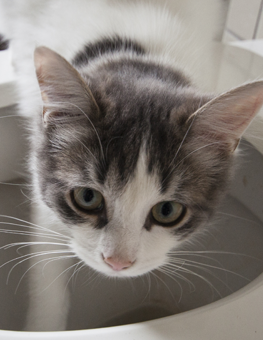All About Catnip
If you are a cat owner, you and your feline friend are most likely familiar with catnip. If you don’t own a cat you have most likely heard of it before or seen it for sale in the pet store. But what is it exactly?

For those 50-70% of cats affected by catnip, it will cause incredible reactions.
Catnip is a perennial herb and a member of the Mint family, Labiatae, and is most commonly known for its ability to get cats “high.” The herb is native to both Europe and Asia and now has been naturalized in America and Canada after being introduced.
It’s hard for humans to understand the sort of reactions cats have to catnip because there isn’t really anything similar we have to compare to. What are the typical types of responses cats have? Well if given to the right cat (only around 50-70% of cats are affected by catnip) it will cause incredible reactions. Cats typically react in similar ways and will rub it, roll over it, kick at it, and mostly go nuts for several minutes. Since animals rely heavily on their noses it’s common to have these types of behaviors triggered by scents. Many people seem to notice the effects change from cat to cat.
How Does Catnip Work
The chemical in catnip that is largely responsible for triggering these kinds of reactions is called nepetalactone which causes a sort of hallucinogenic effect. It’s believed that cats are reacting to similar “feel good” pheromones that are released during sexual courtship and activity when exposed to catnip. For the cats affected, it sends off a stereotypical pattern in their brains causing similar reactions. It is, however, uncommon to see any reactions from very young or senior cats.
The chemical in catnip that is largely responsible for triggering these kinds of reactions is called nepetalactone. It causes a sort of hallucinogenic effect. It’s believed that cats are reacting to similar “feel good” pheromones that are released during sexual courtship and activity when exposed to catnip. For the cats affected, it sends off a stereotypical pattern in their brains causing similar reactions. It is, however, uncommon to see any reactions from very young or senior cats.
What Does Catnip Do to Humans
Catnip also has a variety of effects on humans as well. It is most often consumed as a tea which acts as a sedative. It also has some medicinal uses for humans that have been shown to help settle upset stomachs and treat headaches, coughing, and insomnia. Catnip also acts as a natural pest repellent and is ideal for most gardens. Most garden centers have catnip available for purchase so you can grow your own and requires sandy soil and plenty of sun.

Catnip is not harmful but cat owners should be careful when giving catnip to already aggressive cats.
Is Catnip Safe for Cats?
Catnip is completely non-toxic and not harmful to your cat at all. Most cats will know when they’ve had enough and will refuse any more offerings. Cat owners should however be careful when giving catnip to already aggressive cats as sometimes that behavior becomes escalated. It’s good practice to isolate these cats when offering them catnip if you have a multi-cat household.
Catnip Toys for Cats
Have a cat and never tried giving him or her some catnip? Many toys include catnip and for sure will bring a smile to your cat's face. If it doesn’t, then you may want to give toys with the combination of catnip and silver vine a try. The combination of catnip and the natural cat attractant Silver Vine is most effective, with more than 90% of cats responding.1 Catnip and silver vine toys can be found at your local pet shop, such as:
- Hartz Cattraction with Silver Vine & Catnip® Gator Scratch™ Cat Toy
- Hartz Cattraction with Silver Vine and Catnip® Bell Mouse™ Cat Toy
- Hartz Cattraction with Silver Vine & Catnip® Macaron Mice™ Cat Toy
- Hartz Cattraction with Silver Vine and Catnip® Kitty Frenzy™ Cat Toy
View a full list of Hartz toys that include catnip >
How does your kitty respond to catnip? Do you enjoy watching their reactions?
1 Responsiveness of cat, ©Sebastiaan Bol et al (2017) https://bmcvetres.biomedcentral.com/articles/10.1186/s12917-017-0987-6





